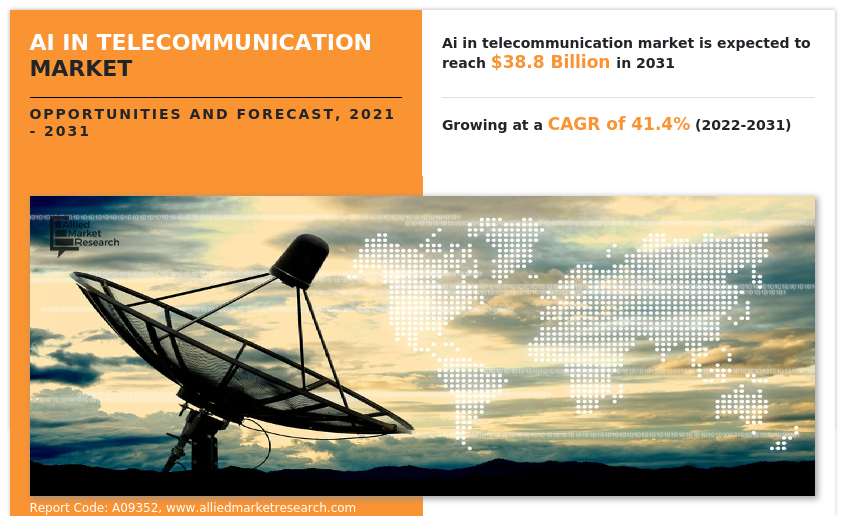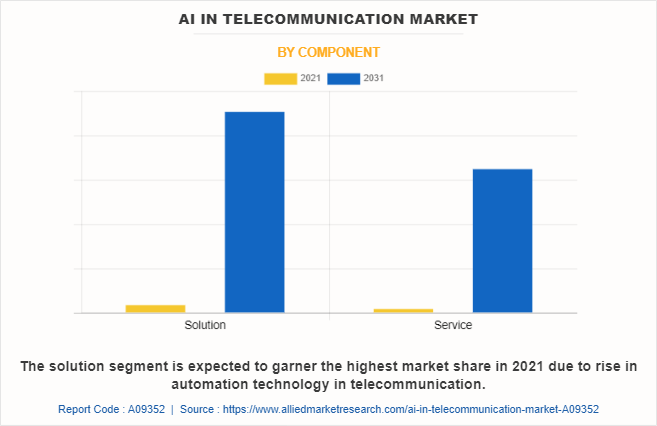AI in Telecommunication Market Insights, 2031
The global AI in telecommunication market size was valued at USD 1.2 billion in 2021, and is projected to reach USD 38.8 billion by 2031, growing at a CAGR of 41.4% from 2022 to 2031.
Artificial Intelligence in telecom uses software & algorithms to estimate human perception in order to analyze big data such as data consumption, call record, and use of the application to improve the customer experience. Also, AI helps telecommunication operators to detect flaws in the network, network security, network optimization & offer virtual assistance. Moreover, AI enables the telecom industry to extract insights from their vast data sets and made it easier to manage the daily business and resolve issues more efficiently and also provide improved customer service and satisfaction.

The growing adoption of AI solutions in various telecom applications is driving market growth. The rising number of AI-enabled smartphones with a number of features such as image recognition, robust security, voice recognition and many as compared to traditional phones is boosting the growth of AI in telecommunication market. Furthermore, to cater to complex processes or telecom services, AI provides a simpler and easier interface in telecommunication.
In addition, growing Over-The-Top (OTT) services, such as video streaming, have transformed the dissemination and consumption of audio and video content. With more consumers turning to OTT services, consumer demand for bandwidth has grown considerably. Carrying such ever-growing traffic from OTT services leads to high operational Expenditure (OpEx) for the telecommunication industry. Hence, AI helps the telecom industry to reduce operational costs by minimizing the human intervention needed for network configuration and maintenance.
However, the major restraint of the AI in telecommunication market is the incompatibility between telecommunication systems and AI technology. Contrarily, the increasing penetration of AI-enabled smartphones in the telecommunication industry, and the advent of 5G technology in smartphones are expected to provide major growth opportunities for the growth of the market. Since advancements such as 5G technology in mobile and the rising need to monitor content on the tale communication network to eliminate human error from telecommunication are driving the growth of the market.
For an instance, the Chinese government trying to improve its network services and telecommunication services; hence China Telecom Corporation has started a new 5G base station in Lanzhou city. Therefore, these factors are expected to provide numerous opportunities for the expansion of the AI in telecommunication market during the forecast period. The market is segmented into Component, Deployment Model, Technology and Application.
Segment Review
The AI in telecommunication market is segmented on the basis of component, deployment model, technology, application, and region. By component, it is segmented into solution, and service. By deployment model, it is bifurcated on-premise, and cloud. By technology, the market is divided into machine learning, natural language processing (NLP), data analytics, and others. By application, it is segmented into customer analytics, network security, network optimization, self-diagnostics, virtual assistance, and others. By region, it is analyzed across North America, Europe, Asia-Pacific and LAMEA.

On the basis of component, the solution segment dominated the overall AI in telecommunication market in 2021 and is expected to continue this trend during the forecast period. This is attributed to the complex communication demands of various large corporations needing custom networking solutions. However, the services segment is expected to witness the highest growth owing to rise in need of professional and managed services to cope with the demand of AI in telecom sector, which is expected to further fuel the growth of the global AI in telecommunication industry.

Region wise, the AI in telecommunication market was dominated by North America in 2021, and is expected to retain its position during the forecast period, owing to its transforming technology and communications sector which is expected to drive the market for AI in telecommunication within the region during the forecast period. However, Asia-Pacific is expected to witness significant growth during the forecast period, owing to its growing digital capabilities and a highly competitive market space, which is anticipated to fuel the AI in telecommunication market growth in the region in the coming few years.
Top Impacting Factors
Growing adoption of AI solutions in various telecom applications
Artificial intelligence in the telecommunication market is gaining traction and popularity as maintenance of the telecom network has become the priority for telecom companies. A network failure reveals the company's lack of honesty and disregard for its clients. Furthermore, network failure also results in financial losses for the company. As a result, AI is being employed to solve this issue.
Moreover, the demand for artificial intelligence in telecommunication is rising as telecom companies can rapidly pinpoint the problem with AI. Finding the first place where maintenance is required takes up the majority of network maintenance time. It has become simple with the availability of AI. Further, telecom companies are leveraging IoT, which is driving the adoption of artificial intelligence in telecommunication. Therefore, the growing adoption of AI solutions in various telecom applications propels the growth of the AI in telecommunication market.
The advent of 5G technology in smartphones
The Telecom industry is in the middle of a transformation from the fourth generation (4G) to the fifth generation (5G) of mobile communications. 5G technology is expected to provide higher data transmission rates with ultra-low latency rates. Furthermore, telecom companies are working to build such infrastructure that supports every vertical controlled by the Internet of Things (IoT). For instance, in March 2020, Google collaborated with AT&T Intellectual Property to help enterprises leverage Google Cloud’s technologies using the 5G network connectivity. Both companies are developing 5G solutions by combining the 5G network capabilities of AT&T Intellectual Property and Google Cloud’s capabilities in analytics, AI/machine learning, and networking. Therefore, these factors will provide major lucrative opportunities for the growth of the AI in telecommunication market.
Incompatibility between telecommunication systems and AI technology
Concerns related to incompatibility, the unreliability of artificial intelligence algorithms, lack of skilled workforce & difficulties in the protection of confidential & private information, are acting as the primary factors that are inhibiting the growth of AI in the telecommunication market during the forecast period. The incompatibility concerns primarily restrict global artificial intelligence in telecommunication market growth as it can generate complexities related to the integration of artificial intelligence in telecommunication solutions. Furthermore, the challenges around compatibility are majorly witnessed due to the lack of standards & protocols in artificial intelligence technologies & the telecommunication sector. Therefore, these are the major factors limiting the growth of the AI in telecommunication market.
Country Specific Statistics & Information
Developing countries such as India and South Korea are increasingly targeted by the key players to develop and launch the AI in telecommunication features into the existing range of products. For instance, in September 2022, Amazon Web Services (AWS) and SK Telecom, the information and communications technology arm of SK Group, the second largest conglomerate in Korea, have announced at Mobile World Congress (MWC) Las Vegas that the two companies will co-develop a new set of computer vision services. This collaboration aims to make it easier and more cost effective for customers to build, use, and scale computer vision applications, which enhance productivity, maintain equipment, and improve facility safety.
COVID-19 Analysis
The global AI in telecommunication market analysis has witnessed stable growth during the COVID-19 pandemic, owing to the dramatically increased digital penetration during the period of COVID-19-induced lockdowns and stringent social distancing policies, which further fueled the demand for remote operational tools such as artificial intelligence tools. Moreover, the Coronavirus/COVID-19 pandemic has highlighted, perhaps more than any other event in human history, the critical role that telecommunications infrastructure plays in keeping businesses, governments, and communities connected and working.
In addition the unexpected social and financial disruption caused by the pandemic has forced individuals all around the world to rely on technology like AI for information, social distance, and even remote working. Furthermore, Artificial Intelligence help the telecom industry to reinvent customer relationships by identifying personalized needs and engaging with customers through hyper-personalized one-to-one contacts. It also helped to configure fixed-line and mobile-network bundles that combine VPN, teleconferencing and productivity apps. These bundles will be particularly attractive to commercial customers whose usage of telecommunication services has shifted from offices to homes and from demand in the field to fixed-line demand. Therefore, such factors propelled the growth of global artificial intelligence in telecommunication market during the period.
Key Developments/ Strategies
- In March 2020, Google collaborated with AT&T Intellectual Property to help enterprises leverage Google Cloud’s technologies using the 5G network connectivity. Both the companies are developing 5G solutions by combining the 5G network capabilities of AT&T Intellectual Property and Google Cloud’s capabilities in analytics, AI/machine learning, and networking.
- In May 2021, Nokia launched AVA Telco AI as a Service, which provides cloud-based artificial intelligence solutions and allows communication service providers (CSP) to automate capacity planning, network management, and service assurance.
Key Benefits for Stakeholders
- The study provides in-depth analysis of the global AI in telecommunication market share along with current & future trends to illustrate the imminent investment pockets.
- Information about key drivers, restrains, & opportunities and their impact analysis on the global AI in telecommunication market trends are provided in the report.
- Porter’s five forces analysis illustrates the potency of buyers and suppliers operating in the AI in telecommunication industry.
- An extensive analysis of the key segments of the industry helps to understand the global AI in telecommunication market forecast.
AI in Telecommunication Market Report Highlights
| Aspects | Details |
| Market Size By 2031 | USD 38.8 billion |
| Growth Rate | CAGR of 41.4% |
| Forecast period | 2021 - 2031 |
| Report Pages | 280 |
| By Component |
|
| By Deployment Model |
|
| By Technology |
|
| By Application |
|
| By Region |
|
| Key Market Players | ZTE Corporation, Salesforce, Inc., IBM Corporation, AT&T, Google LLC, Infosys Limited, Nuance Communications, Inc., Microsoft, Intel Corporation, Cisco Systems, Inc. |
Analyst Review
Telecommunications is one of the fastest-growing industries that use AI in many aspects of their business, including improving customer experience and network reliability. Telecom companies use AI primarily for customer service applications. For instance, the use of chatbots and virtual assistants to address a massive number of support requests for installation, maintenance, and troubleshooting. Furthermore, AI integration in the telecommunication industry permits personnel to remove insightful details from large data sets and achieve ease of managing daily business activities as well as resolve problems more efficiently, thereby leading to greater customer satisfaction. In addition, telecommunication operators are considering advanced technologies such as AI & machine learning to implement in the 5G system for the realization of highly self-organized, intelligent management & fault-free networks that are much more reliable as compared to the earlier networks.
For instance, in October 2021, IBM collaborates and expanded partner relationships to further the company's capabilities in hybrid cloud, AI, network automation, and security at Mobile World Congress Los Angeles (MWC LA). These innovations highlight IBM's role in helping the telecommunications industry evolve as 5G and edge computing redefine how businesses and consumers connect. Moreover, IBM continues to make major strides in helping CSPs adopt AI and automation on open hybrid cloud platforms, as well as standards to remain in control of where and how they deploy their network services, edge computing, and enterprise offerings. By leveraging IBM's AI-powered automation software, such as IBM Cloud Pak for Network Automation, and services through IBM Consulting, IBM helps drive innovation for CSPs through its systems integration capabilities; the application of technology to create ever more intelligent workflows and supports modernizing applications so enterprises can deliver at scale in a world of hybrid cloud environments.
The global AI in telecommunication market size was valued at USD 1.2 billion in 2021, and is projected to reach USD 38.8 billion by 2031.
The AI in telecommunication is projected to grow at a compound annual growth rate of 41.4% from 2021-2030 to reach USD 38.8 billion by 2031
AT&T, Cisco Systems, Inc., Google, LLC, IBM Corporation, Infosys Limited, Intel Corporation, Microsoft, Nuance Communications, Inc, Salesforce, Inc., and ZTE Corporation
North America is the largest regional market for AI in telecommunication market.
The growing adoption of AI solutions in various telecom applications and use of AI in telecommunication to reduce operational costs are the major factors driving the market growth.
Loading Table Of Content...
Loading Research Methodology...



